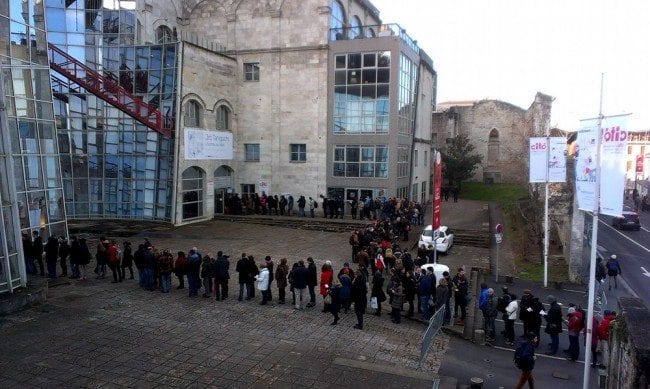
It's now Saturday and people are here in force. The lines to get into tents and exhibitions are predictably around the proverbial block, even at the Cité de la Bande Dessinée, which usually provides sanctuary for the crowds on the Saturdays. Getting to see the Taniguchi Jiro exhibition there requires patience. The comics festival as potential flashpoint.
As reported widely, the Charlie Hebdo massacre has prompted the creation of a new, annual "Freedom of Speech" award here at the Angoulême festival. This was in part prompted by an impromptu online petition to have the Grand Prix awarded to the magazine, launched by cartoonist Gwen de Bonneval a few weeks ago. This quickly gained more than 4,000 signatures, including some by prominent figures in French comics. This prompted reflection: was the august Grand Prix suddenly to be awarded as a political gesture, rather than, as it had been, a lifetime achievement award?
As usual when there have been disagreements about whom to award, festival management came up with a new one. But rather than being a one-off, it will be ongoing. This seems a good solution and a timely way to acknowledge officially that comics and cartooning have emerged prominently in the public sphere, surely to stay at the forefront of difficult issues concerning free speech, globalization, and pluralism.
Overall, however, the general mood seems to be one of wishing to move on and concentrate on other things. There are so many wonderful things happening in comics, so why not concentrate on some of those? Perhaps that's even the best way of honoring the dead? Certainly better than ringing the bells of Notre Dame in honor of a fervently atheist journal, as happened in Paris a few weeks ago. As cartoonist, publisher, and child of Charlie Jean-Christophe Menu, who accepted the award on behalf of the journal, said, "The spirit of Charlie is not to turn into heroes satirists who shat on people in power, to ring the bells of Notre Dame for anti-clericals. It is to call the mayor of Angoulême an asshole when he fences in public benches." The last is a reference to a decision taken in December and since reversed to prevent the homeless from sleeping rough in public.
But we were talking about good things in comics. Among them are several good exhibitions. Chief among them is the Alex Barbier retrospective. Barbier is one of those comics makers working on the margins, slowly creating a highly distinctive if mostly ignored body of work. His painted comics are hallucinatory, internal, and intense explorations of sex, power and alienation, rendered in saturated if often murky watercolor over thick inks. Appropriately, he debuted in Charlie with the first installment of the now classic Lycaons in 1974 when Wolinski (RIP) took a chance on the young artiste.

There is something of Francis Bacon about Barbier's sensibility as an artist -- his work is similarly oppressive in outlook, while inevitably less accomplished technically, Especially the oil paintings that intersperse the glowing comics pages in the show reveal weaknesses. Curator Thierry van Hasselt has pitched the show extremely well, with analytical explanatory labels and intelligent juxtapositions. One display case brings together Barbier's literary inspirations, from Burroughs, Céline, and Victor Hugo to Bram Stoker, André Franquin, and Victor Hubinon. Most revelatory is a painted comics magazine cover by the Belgian illustrator Mitocq, whose use of gouache clearly informs Barbier. A highly original, important voice in comics celebrated appropriately at a time when he has decided to quit the medium with a final book Dernière Bande.
Jack Kirby is also prominent in the programming here, centered around a big exhibition in the bizarre Monde de Bulles tent, curated by Kirby expert and biographer Jean Depelley. Those expecting to see original pages by the King will be disappointed, but if one manages to disregard that, it is a very well-conceived show, using hundreds of photostats of key covers and pages (shot both from the comics and original artwork) to deliver a four-color assault on the senses and make an excellent case for Kirby's significance as a creator. Perhaps the best idea is found in the section devoted to Kirby's many inkers, which besides explaining how important their contributions were, enables visitors to try their own hand at inking the master and thereby understanding the process that much better.

Another nice surprise is the new Chinese pavilion, discussed in my report from yesterday. One might have feared asinine cultural propaganda, but it really is well conceived, combining new and old, comics, film, and animation. Of special interest is a section devoted to classic Chinese comics, by such creators as He Youzhi (b. 1922), Zhang Leping (1910-1992), and Wang Hongli (b. 1927), represented by original strips lent by the China Art Museum in Shanghai. Great masters, clearly, that I for one had never before heard about.
Comics: it's a wide and wonderful world sometimes.
Thanks to Erik Barkman for the photo at top.






